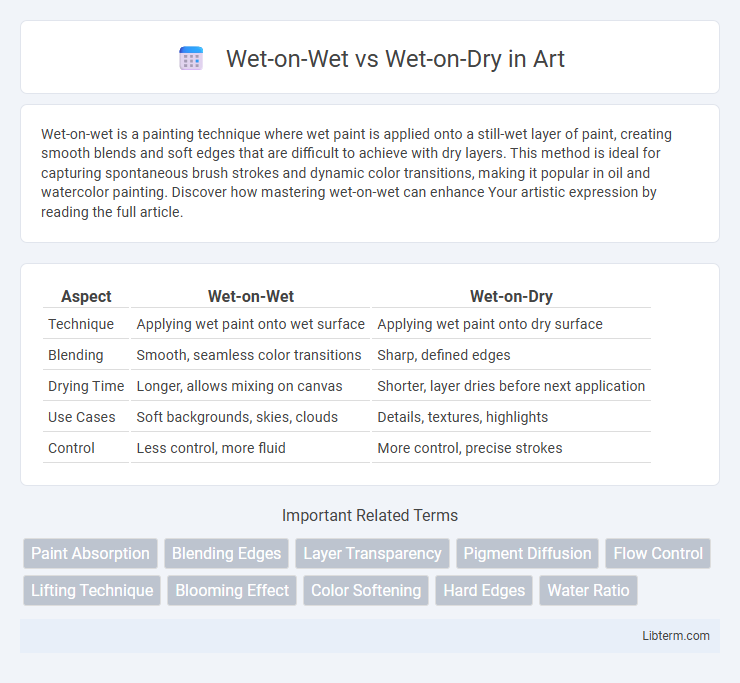Wet-on-wet is a painting technique where wet paint is applied onto a still-wet layer of paint, creating smooth blends and soft edges that are difficult to achieve with dry layers. This method is ideal for capturing spontaneous brush strokes and dynamic color transitions, making it popular in oil and watercolor painting. Discover how mastering wet-on-wet can enhance Your artistic expression by reading the full article.
Table of Comparison
| Aspect | Wet-on-Wet | Wet-on-Dry |
|---|---|---|
| Technique | Applying wet paint onto wet surface | Applying wet paint onto dry surface |
| Blending | Smooth, seamless color transitions | Sharp, defined edges |
| Drying Time | Longer, allows mixing on canvas | Shorter, layer dries before next application |
| Use Cases | Soft backgrounds, skies, clouds | Details, textures, highlights |
| Control | Less control, more fluid | More control, precise strokes |
Introduction to Watercolor Techniques
Wet-on-wet watercolor technique involves applying wet paint onto a wet surface, creating soft edges and fluid color blending ideal for atmospheric effects and backgrounds. Wet-on-dry technique, where wet paint is applied to a dry surface, produces sharp, defined edges and precise details suitable for controlled, intricate work. Mastery of both techniques enables artists to manipulate watercolor textures and layering for dynamic compositions.
Understanding Wet-on-Wet Painting
Wet-on-wet painting, also known as alla prima, involves applying fresh paint onto a still-wet layer, creating smooth blending and soft edges ideal for capturing light and atmosphere quickly. This technique enhances color mixing directly on the canvas, allowing artists to achieve fluid gradients and spontaneous effects that differ from the crisp, defined strokes of wet-on-dry painting. Mastery of wet-on-wet requires attention to paint consistency and timing to prevent unintended muddiness while exploiting its dynamic, expressive potential.
Exploring Wet-on-Dry Painting
Wet-on-dry painting involves applying wet paint onto a fully dried layer, enabling greater control and precision in detailing and layering. This technique allows artists to build textures and distinct edges without colors blending uncontrollably, making it ideal for fine lines and defined shapes. Wet-on-dry methods are favored in acrylic and oil painting for achieving sharp contrasts and intricate compositions.
Key Differences: Wet-on-Wet vs Wet-on-Dry
Wet-on-wet painting involves applying fresh paint onto an already wet surface, allowing colors to blend smoothly and create soft transitions. Wet-on-dry technique requires applying wet paint onto a dry layer, producing sharper edges and more defined details. The key difference lies in the drying time and blending effect, with wet-on-wet promoting fluid mixing and wet-on-dry enabling precise layering.
Materials Needed for Both Techniques
Wet-on-Wet painting requires a palette of fluid acrylics or oils, brushes with soft bristles for smooth blending, and a primed, absorbent canvas or paper to facilitate seamless color mixing directly on the surface. Wet-on-Dry technique demands thicker paint consistency, a range of brush types including fine detail brushes for precise layering, and a properly dried base coat that ensures crisp edges and controlled application. Both methods benefit from quality solvents or mediums like linseed oil for oils or water for acrylics to adjust paint viscosity and drying times.
Visual Effects and Texture Comparison
Wet-on-wet painting produces softer edges and smooth color transitions, creating blended visual effects ideal for atmospheric scenes and gradients. Wet-on-dry techniques yield sharper lines and more defined textures, enhancing detail and contrast suitable for intricate designs and layered compositions. Comparing the two, wet-on-wet emphasizes fluidity and tonal harmony, while wet-on-dry prioritizes precision and surface texture distinctiveness.
Suitable Subjects for Each Method
Wet-on-wet technique excels in creating smooth gradients and soft blends, making it suitable for landscapes, skies, and floral paintings where seamless transitions are desired. Wet-on-dry is ideal for detailed subjects such as portraits, architectural elements, and still life, allowing for precise edges and layered textures. Artists often select wet-on-wet for impressionistic effects and wet-on-dry for controlled, refined results.
Common Challenges and Solutions
Wet-on-Wet painting often faces challenges like color blending loss and muddy tones due to simultaneous wet layers, while wet-on-dry struggles with visible brushstrokes and slower drying times affecting layering precision. Artists overcome wet-on-wet issues by controlling paint thickness and timing to maintain vibrancy, whereas wet-on-dry techniques benefit from using fast-drying mediums and smooth brushwork to achieve clean edges. Mastering drying times and paint consistency is key to resolving common difficulties in both methods, enhancing texture control and color accuracy.
Expert Tips for Mastering Both Techniques
Mastering wet-on-wet and wet-on-dry painting techniques requires understanding paint consistency and drying times; wet-on-wet allows fluid blending for soft gradients, while wet-on-dry produces sharp edges and detailed layering. Experts recommend using synthetic brushes and high-quality, slow-drying oils for wet-on-wet to maintain workable paint, whereas firm bristle brushes and quick-drying acrylics suit wet-on-dry applications for precision. Practicing controlled brush pressure and paint load optimizes color mixing and texture effects in both methods, enhancing versatility and artistic control.
Which Technique is Right for Your Project?
Choosing between wet-on-wet and wet-on-dry painting techniques depends on the desired texture and blending effects for your project. Wet-on-wet allows for smooth transitions and soft edges, ideal for atmospheric landscapes and fluid, spontaneous artwork, while wet-on-dry provides sharp, defined lines and layering capability, perfect for detailed illustrations and controlled compositions. Assessing the project's style, drying time, and color blending needs will help determine the most suitable technique for optimal results.
Wet-on-Wet Infographic

 libterm.com
libterm.com